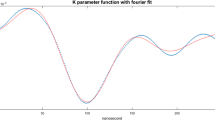Abstract
To enhance the approximation and generalization ability of artificial neural networks (ANNs) by employing the principle of quantum rotation gate and controlled-not gate, a quantum-inspired neuron with sequence input is proposed. In the proposed model, the discrete sequence input is represented by the qubits, which, as the control qubits of the controlled-not gate after being rotated by the quantum rotation gates, control the target qubit for reverse. The model output is described by the probability amplitude of state \(|1\rangle \) in the target qubit. Then a quantum-inspired neural networks (QINN) is designed by employing the quantum-inspired neurons to the hidden layer and the common neurons to the output layer. The algorithm of QINN is derived by employing the Levenberg–Marquardt algorithm. Simulation results of some benchmark problems show that, under a certain condition, the QINN is obviously superior to the classical ANN.
















Similar content being viewed by others
References
Tsoi AC, Back AD (1994) Locally recurrent globally feed-forward networks: a critical review of architectures. IEEE Trans Neural Netw 7:229–239
Kleinfeld D (1986) Sequential state generation by model neural networks. In: Proceedings of the National Academy of Sciences of the United States of America, pp 9469–9473
Waibel A, Hanazawa T, Hinton G (1989) Phoneme recognition using time-delay neural networks. IEEE Trans Acoust Speech Signal Process 37:328–339
Lippmann RP (1989) Review of neural networks for speech recognition. Neural Comput 1:1–38
Maria M, Marios A, Chris C (2011) Artificial neural networks for earthquake prediction using time series magnitude data or seismic electric signals. Expert Syst Appl 38:15032–15039
Kak S (1995) On quantum neural computing. Inf Sci 83:143–160
Kouda N, Matsui N, Nishimura H, Peper F (2005) Qubit neural networks and its learning efficiency. Neural Comput Appl 14:114–121
Zak M, Williams CP (1998) Quantum neural nets. Int J Theor Phys 37:651–684
Maeda M, Suenaga M, Miyajima H (2007) Qubit neuron according to quantum circuit for XOR problem. Appl Math Comput 185:1015–1025
Gupta S, Zia RK (2001) Quantum neural networks. J Comput Syst Sci 63:355–383
Shafee F (2007) Neural networks with quantum gated nodes. Eng Appl Artif Intell 20:429–437
Li PC, Li SY (2008) Learning algorithm and application of quantum BP neural networks based on universal quantum gates. J Syst Eng Electron 19:167–174
Li PC, Song KP, Yang EL (2010) Model and algorithm of neural networks with quantum gated nodes. Neural Netw World 11:189–206
Adenilton J, Wilson R, Teresa B (2012) Classical and superposed learning for quantum weightless neural networks. Neurocomputing 75:52–60
Gonzalez-Carrasco I, Garcia-Crespo A, Ruiz-Mezcua B, Lopez-Cuadrado JL (2011) Dealing with limited data in ballistic impact scenarios: an empirical comparison of different neural network approaches. Appl Intell 35:89–109
Gonzalez-Carrasco I, Garcia-Crespo A, Ruiz-Mezcua B, Lopez-Cuadrado JL (2012) An optimization methodology for machine learning strategies and regression problems in ballistic impact scenarios. Appl Intell 36:424–441
Martin TH, Howard BD, Mark HB (1996) Neural network design. PWS Publishing Company, USA
Acknowledgments
We thank the two anonymous reviewers sincerely for their constructive comments and suggestions, which have tremendously improved the presentation and quality of this paper. This work was supported by the National Natural Science Foundation of China (Grant No. 61170132).
Author information
Authors and Affiliations
Corresponding author
Rights and permissions
About this article
Cite this article
Li, P., Xiao, H. Sequence Input-Based Quantum-Inspired Neural Networks with Applications. Neural Process Lett 40, 143–168 (2014). https://doi.org/10.1007/s11063-013-9316-7
Published:
Issue Date:
DOI: https://doi.org/10.1007/s11063-013-9316-7




